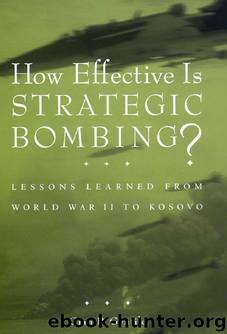How Effective Is Strategic Bombing?: Lessons Learned from World War II to Kosovo by Gian P. Gentile

Author:Gian P. Gentile [Gian P. Gentile]
Language: eng
Format: epub
Tags: aVe4EvA
ISBN: 9780585425221
Publisher: NYU Press
Published: 2000-05-08T20:00:00+00:00
A Comparison of the United States Strategic Bombing Survey with the Gulf War Air Power Survey
[According to Pentagon gossip] it appears we are in the grip of historians.
eliot cohen, 1992
After World War II, Bernard Brodie and other defense analysts read, and often used, many of the United States Strategic Bombing Survey (USSBS) conclusions in their postwar writings on military strategy and defense policy and organization. The Survey’s published studies provided postwar analysts with a wealth of evidence to support their wide-ranging arguments. The reports of the USSBS also helped the air force in its postwar fight for independence, and provided support to both the air force and the navy in the fierce interservice battles over defense funding in 1949.
The “internal war” between the military services over defense dollars and organization turned to actual war in late June 1950 when North Korea attacked South Korea across the 38th parallel. The Korean War was indeed a very different type of war to the American military, especially the United States Air Force.1 If the political objectives of World War II that airmen helped to achieve were the unconditional surrenders of Germany and Japan, the political objectives of the Truman Administration in Korea were much more limited. Instead of attacking what most airmen believed to be the root cause of the war in Korea—the Soviet Union and later China— President Truman restricted the use of American air power to the Korean Peninsula.2 The airmen were thus limited to bombing a small number of strategic targets in North Korea and to supporting the ground operations of the army.3
When it came to evaluating the effects of air power in the Korean War, members of the Air Staff thought that another study like the World War II USSBS was unnecessary since the preponderance of air power used in Korea was “tactical interdiction.”4 The Korean War did not fit airmen’s conceptual understanding of the primary use of strategic air power and therefore did not warrant a civilian-led evaluation on the scale of the USSBS. Neither would the next limited war fought by the United States after Korea.
In 1965, as the United States was beginning its large-scale military involvement in the Vietnam War, erstwhile air force chief of staff General Curtis E. LeMay boasted that in order for the United States to win in South East Asia it should use strategic air power to bomb North Vietnam “back into the Stone Age.”5 LeMay ignored the relative fact that, compared with the industrial might of the United States, North Vietnam was already in the “Stone Age.”
The World War II USSBS informed the airmen that the way to use strategic air power in Vietnam was to bomb the enemy’s war-making capacity. The American air chiefs believed that the air force’s approach to fighting a strategic air war—shaped by the World War II experience much more than by Korea—was adaptable to any type of conflict, including a limited war in Vietnam.6
As the war progressed, however, airmen were unhappy with the gradual, limited approach to bombing North Vietnam forced upon them by their civilian masters.
Download
This site does not store any files on its server. We only index and link to content provided by other sites. Please contact the content providers to delete copyright contents if any and email us, we'll remove relevant links or contents immediately.
| Africa | Americas |
| Arctic & Antarctica | Asia |
| Australia & Oceania | Europe |
| Middle East | Russia |
| United States | World |
| Ancient Civilizations | Military |
| Historical Study & Educational Resources |
The Radium Girls by Kate Moore(11604)
100 Deadly Skills by Clint Emerson(4683)
The Templars by Dan Jones(4555)
Rise and Kill First by Ronen Bergman(4542)
The Doomsday Machine by Daniel Ellsberg(4240)
The Rape of Nanking by Iris Chang(4016)
Killing England by Bill O'Reilly(3896)
Hitler in Los Angeles by Steven J. Ross(3795)
Stalin by Stephen Kotkin(3719)
12 Strong by Doug Stanton(3412)
Hitler's Monsters by Eric Kurlander(3154)
Blood and Sand by Alex Von Tunzelmann(3054)
Darkest Hour by Anthony McCarten(3016)
The Code Book by Simon Singh(2853)
The Art of War Visualized by Jessica Hagy(2832)
Hitler's Flying Saucers: A Guide to German Flying Discs of the Second World War by Stevens Henry(2620)
Babylon's Ark by Lawrence Anthony(2427)
The Second World Wars by Victor Davis Hanson(2419)
Tobruk by Peter Fitzsimons(2373)
